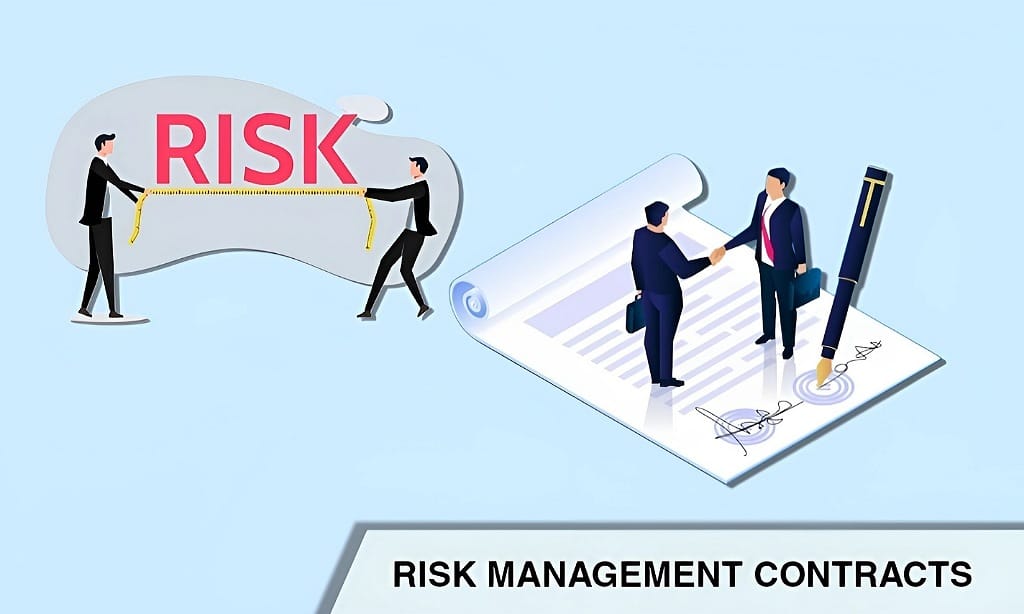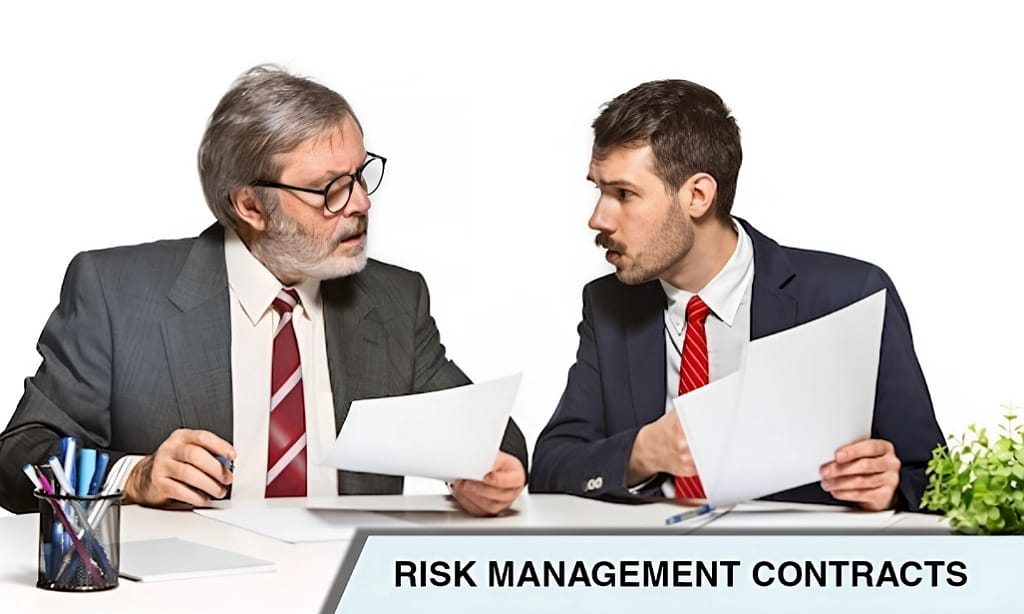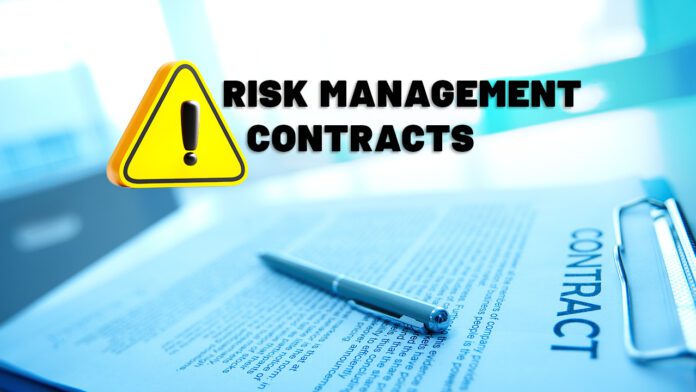In the fast-paced world of business, contracts are like lifeboats in the rough sea—they keep your company afloat amidst potential legal storms. But not all lifeboats are created equal.
You might be asking yourself how to ensure that your contracts hold up when waves come crashing down. That’s where knowing how to manage contract risks becomes essential.
Did you know that every deal Harvard University enters must meet specific criteria, such as offer and acceptance, to protect its interests? This fact alone sheds light on the importance of solid contract risk management for institutions large and small.
Our guide takes these complexities and breaks them into bite-sized pieces so that, by the end, you’ll have a sturdy vessel ready to weather any kind of contract squall with confidence.
Dive into our actionable strategies designed specifically for protecting your business from contractual pitfalls. Ready for smoother sailing? Keep reading, and let’s set sail toward risk management contracts horizons!
Understanding Contract Risk
In the realm of business, contract risk is an ever-present shadow that can cast a long and costly pall if left unchecked. It’s the potential for loss or damage stemming from a contractual agreement, and without proper management, it can result in significant financial and reputational detriment. Understanding its contours is the first step towards taming this formidable beast.
Definition of Contract Risk
Contract risk pops up when doing business with others. It’s the chance something might go wrong in a deal or agreement, like someone not sticking to their word or unexpected costs.
Contracts are key for Harvard and other places because they cover lots of deals, from buying stuff to hiring experts.
Dealing with these risks means knowing what could happen and using smart steps to lower the chances of problems. To keep control over how much risk costs at Harvard, everyone has to treat contract risks right every time.
This helps avoid surprises that can cost a lot of money or cause other headaches in important projects and plans.
Different Types of Contract Risk
Contracts are like promises that can lead to trouble if not handled with care. They carry risks that may harm your business in many ways.
- Financial Risk: If a party cannot pay or meet the contract terms, you could lose money. Think about setting limits on how much risk you’re willing to take.
- Legal Liability: When agreements are broken, there might be lawsuits. Use clear terms and conditions to reduce misunderstandings.
- Reputational Harm: Bad deals can hurt your name. Keep this in mind when choosing who to do business with.
- Security Risks: Sensitive information might get out through contracts. Always add confidentiality clauses to protect your data.
- Non-Compliance: Breaking rules can mean penalties. Make sure your contracts follow all the laws and regulations.
- Business Objectives Misalignment: Ensure what’s written lines up with your company’s goals before you sign anything.
- Ambiguities in Contract Language: Unclear words can cause conflicts. Use precise language and define key terms well.
Exploring Risk Management Contracts

Delve into the intricacies of contract risk management—it’s your safeguard in a world where legal agreements can make or break your business. Unearth the significance of establishing solid protocols that not only shield you from potential pitfalls but also fortify your company’s foundation for future endeavors.
What is Contract Risk Management?
Contract risk management is the process of identifying, assessing, and controlling threats linked to legal agreements. This includes creating strategies to minimize risks such as financial loss, legal disputes, or damage to relationships.
Businesses use this approach to protect their interests and ensure that the terms of a contract are fair and manageable.
Key steps involve checking contracts for clauses like indemnification and risk transfers. A solid risk management plan helps businesses define acceptable levels of risk. It also guides how they handle potential issues with vendors, independent contractors, landlords, or buyers in the supply chain.
The goal is a clear understanding between parties about who takes on which risks if something goes wrong. This proactive treatment saves money by avoiding unexpected problems later on.
Importance of Contract Risk Management
Contract risk management is like a safety net for businesses. It helps you spot possible problems before they happen. Think of it as looking both ways before crossing the street. By managing risks, companies can save money and avoid trouble.
Strong contract risk management means fewer surprises in your deals. You make better choices because you understand the risks ahead of time. This leads to healthier contracts and smoother business operations overall.
Guidelines for Effective Contract Risk Management
To navigate the minefield of contractual uncertainties, adopting a robust set of guidelines for managing contract risk is paramount. This strategic approach not only safeguards your business interests but enhances decision-making processes as you engage with partners and vendors in today’s dynamic market landscape.
Establishing Risk Appetite in Contract Management
Establishing your risk appetite means deciding how much risk you’re willing to take in contract management. Think of it like choosing what rides to go on at a fair. Some people love big, thrilling roller coasters, while others prefer the calm carousel.
In business, this could be picking contracts with bigger rewards but higher risks or safer deals with smaller gains.
Set clear rules for the types and amounts of risk you can accept. This keeps everyone on the same page and protects your business from taking on too much danger. It’s like setting a budget before shopping; you know what you can spend without getting into trouble.
When managing contracts for Harvard, always choose wisely to avoid putting the university at unnecessary risk.
Use tools like a Risk Assessment Matrix to judge different risks in each contract accurately. This helps in spotting potential problems early on, just like checking weather reports before sailing out to sea! And remember that proper handling of these risks is key to controlling costs and keeping your contracting process healthy.
Utilizing a Risk Assessment Matrix
A risk assessment matrix helps spot the big risks in your contracts. Use it to take control and keep surprises away.
- Identify all risks related to your contract. Consider financial risks, construction delays, and legal issues.
- Categorize each risk by its level of severity. Is it low, medium, or high impact?
- Determine the likelihood of each risk happening. Will it likely occur or is it a rare chance?
- Map out risks on the matrix grid. Place them where severity and likelihood intersect.
- Focus on the top-right quadrant first. These are your high-impact, high-probability risks.
- Develop strategies for every high – risk scenario. Plan steps to reduce or avoid these dangers.
- Review lower quadrant risks too. Even small problems can grow if ignored.
- Update the matrix regularly as new information comes in. Keep it current to stay prepared.
- Share the matrix with key team members. Ensure everyone understands the risks involved.
- Integrate findings into your overall business strategy. Align risk actions with company goals.
Automating Contract Data Mining & Identification
Use automation to streamline the process of finding and sorting contract data. This smart move saves time and cuts down on mistakes. It’s like having a digital assistant that works non-stop, scanning each contract for important details such as insurance clauses, indemnity terms, and risk transfer provisions.
By setting up this system, your business ensures everyone sticks to agreed-upon insurance minimums without fail.
Automating also means staying ahead in managing risks before they become real problems. Think of it as putting up a strong defense against legal troubles or financial hits by making sure no contract detail gets missed.
Clear standards keep risks low and make sure every agreement follows the rules. Plus, your team can focus on more strategic tasks while automation handles the heavy lifting of contract analysis.
Implementing Hands-On Risk Reduction Actions

Risk reduction actions are a must for smart contract management. You can keep contracts safe and control risks with these steps:
- Review indemnification clauses: Check that your contracts have clear terms to protect against legal liability. This includes who is responsible if something goes wrong.
- Require insurance coverage: Make sure the other party has insurance. This will help cover any losses or damages.
- Perform due diligence: Always research who you’re working with. Confirm they have the resources to meet their contract duties.
- Utilize automation wisely: Employ software to track and manage risks in contracts automatically.
- Set clear risk metrics: Decide what level of risk is acceptable for each contract and stick to it.
- Include limitation of liability clauses: Limit how much your company can be blamed for issues related to the contract.
- Regularly update internal audits: Schedule checks on how well risks are being managed within your contracts.
- Embrace AI advancements: Use AI tools to predict potential risks and prevent them early in the contracting process.
- Train employees regularly: Ensure staff members understand how to identify and handle contract risks effectively.
- Stay up-to-date with regulations: Keep track of changes in laws that affect your contracts and adjust as needed.
- Create hands-on response plans: Develop clear steps to take quickly if a risk turns into a real problem.
- Encourage open communication channels: Make sure everyone involved in a contract can easily discuss any concerns about risks.
- Verify counterparties’ financial stability: Before signing, make sure they’re economically sound enough to fulfill their obligations.
- Negotiate favorable terms vigilantly: Always aim for conditions that minimize your company’s exposure to risk.
- Document all risk analysis processes meticulously: Good records help manage future contracts and support decisions made during negotiations.
Setting up a Contract Risk AI Machine Learning Schedule
Plan your AI schedule for contract risk management carefully. Start by mapping out key milestones and tasks necessary to integrate machine learning into the process. Make sure to allocate time for data collection, model training, and testing phases.
Check that each step has clear objectives and deadlines.
Use machine learning algorithms to analyze contracts and spot potential risks quickly. These tools can predict which contracts may lead to issues based on past data patterns. Set up regular intervals for the AI system to learn from new contracts and improve its predictions over time.
This proactive approach helps in managing risks before they become problems.
Mitigating Contract Risk: Best Practices for 2024
Check all contracts for clear terms and conditions. Make sure each party knows their duties and rights. Use plain language to avoid confusion. Add clauses that hold harmless and provide remedies if things go wrong.
Stay updated on new laws that affect your contracts. Train your team on risk management trends and tools, like AI-powered analytics. Set up alerts for changes in regulations to keep contracts compliant.
Use contract risk management software with cloud-based solutions for easy access anywhere. Make sure the software can handle end-to-end contract lifecycle needs, from creating to signing to renewing agreements.
Foster strong relationships with insurers and indemnitors early in the contracting process. Discuss acceptable risks together and find insurance options that fit everyone’s needs.
Always prepare a Plan B for unforeseen events in every contract you make or sign. Consider force majeure clauses as part of this plan so you’re ready if big disruptions happen.
Establish key performance indicators (KPIs) to track how well your risk strategies work over time. Adjust these KPIs as needed based on what you learn from data analytics or changes in business models.
Role of Contract Risk Management Software
Leverage the power of Contract Risk Management Software to streamline your business processes and enhance decision-making. This tech-savvy tool is designed to pinpoint potential risks in contract portfolios, ensuring you stay ahead of the curve with proactive measures that protect your company’s interests.
Benefits of Contract Risk Management Software
Contract risk management software is key to protecting businesses from legal and financial harm. It streamlines the entire process for commercial transactions.
- Saves Time: These programs quickly sort through contracts, finding important details faster than a human can.
- Reduces Errors: The software checks for mistakes automatically, ensuring that nothing gets missed.
- Increases Visibility: You can see all your contracts in one place, making it easy to manage them and find potential risks.
- Improves Compliance: This technology makes sure your contracts follow current laws and standards, keeping you out of trouble.
- Automates Reminders: Never miss a deadline again with automatic alerts about upcoming contract events.
- Encourages Consistency: It helps standardize your contracts so each one follows the same rules and format.
- Enhances Security: Your sensitive contract data stays protected against unauthorized access with strong security features.
- Assists Decision Making: With better information at your fingertips, you can make smarter choices about handling contracts and risks.
How to Choose the Right Contract Risk Management Software
Choosing the right contract risk management software can streamline your company’s processes. It ensures that contracts are handled with care and efficiency.
- Identify your business needs. Assess risks, workflows, and compliance requirements unique to your organization.
- Look for user – friendly interfaces. Software should be easy to navigate for all team members, regardless of their tech skills.
- Ensure compatibility with existing systems. The software must work well with other tools you use such as cloud-based platforms or in-house databases.
- Check for automation features. Leading software often includes AI and natural language processing to help manage data effectively.
- Demand robust security measures. Protect sensitive information with advanced analytics and information security protocols.
- Review the support and training options. Get a clear understanding of the help available for onboarding and troubleshooting.
- Seek software that evolves with your company. Solutions like CobbleStone Contract Insight® learn from new data regularly.
- Optimize contract visibility. Dashboards and version control features should provide a clear view of all contract stages.
- Consider integration capabilities. Look at how well the software can mesh with finance, procurement, or quality management systems.
- Verify compliance standards met by the software such as ISO 9000 and ISO 31000 guidelines for risk management.
Fundamental Shifts in Contract Risk Management
Contract risk management is changing fast. Companies now focus more on prevention than reaction. They use smart tools to find risks before they turn into big problems. Cloud-based software helps track contracts in real-time.
People can see where the risks are quickly.
Tech is a game-changer for keeping contracts safe. Artificial Intelligence (AI) and machine learning look at data to spot warning signs early. This means less surprise from hidden contract issues.
Firms create stronger agreements by predicting possible troubles with help from AI insights.
Get Started: Tools and Strategies for Contract Risk Management
Managing contract risks effectively is a must for business professionals. Here are tools and strategies to help you guard against potential issues:
- Establish a clear risk appetite. Decide how much risk your organization can handle before entering any agreement.
- Use a risk assessment matrix. This tool helps you rate the likelihood and impact of different risks.
- Implement automated data mining. Computer programs can find critical contract information fast.
- Create an AI machine learning schedule. Teach computers to predict and manage risks over time.
- Select top-notch contract management software. Look for cloud-based systems that offer electronic signatures and easy file storage.
- Train your team regularly. Ensure everyone understands their role in managing contract risks.
- Review contracts thoroughly. Check for warranties, liabilities, and other legal terms before signing.
- Conduct SWOT analysis. Identify strengths, weaknesses, opportunities, and threats related to each contract.
- Seek expert advice when needed. Lawyers and auditors can offer valuable insights into complex deals.
- Stay updated with legaltech trends. They can give you an edge in managing contract risks more efficiently.
Conclusion
Managing contracts takes skill and care. You now know how to spot risks and keep them low. Use smart tools and follow the best steps we talked about. Stay ahead by watching for new changes in the field.
Good luck with your risk management journey!




![How Much is Lil Baby’s Net Worth in 2024 [Latest Info] Lil Baby Net Worth](https://www.wariat.org/wp-content/uploads/2024/03/Lil-Baby-Net-Worth-150x150.jpg)
![Rob Lowe Net Worth Speculation in 2024 [Comparative Analysis] Rob Lowe Net Worth](https://www.wariat.org/wp-content/uploads/2024/03/Rob-Lowe-Net-Worth-150x150.jpg)

